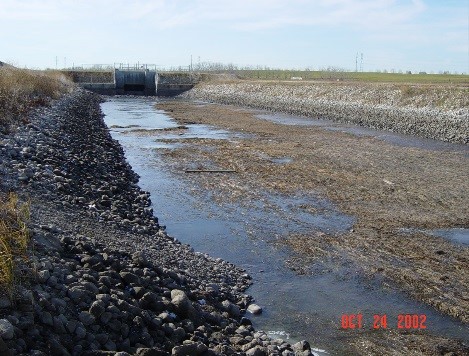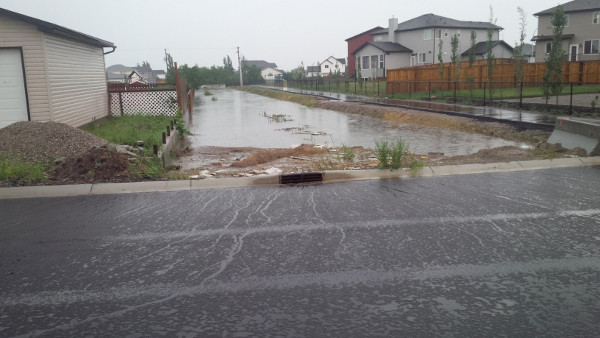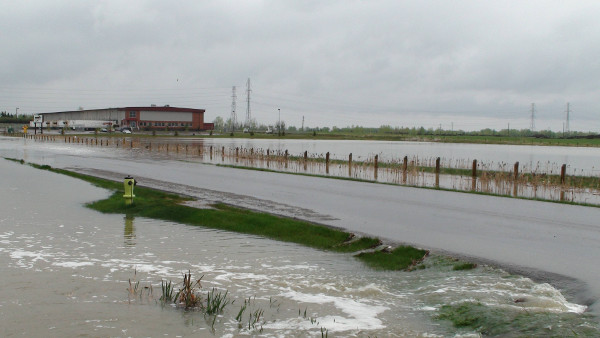CSMI – project need and benefits
Project need and benefits
1. Maintain water quality
The CSMI will maintain the quality of irrigation water by limiting the amount of stormwater entering the irrigation main canals and reservoirs.
Generally, stormwater runoff within the CSMI region naturally flows towards the irrigation delivery system. The irrigation system includes the Western Headworks (WH) canal owned by AEPA that feeds into the WID irrigation reservoir (commonly referred to as Chestermere Lake), the main canals and reservoirs of the WID, and Weed Lake which is owned and operated by Rocky View County, Ducks Unlimited Canada, and AEPA. Even stormwater that doesn’t drain into the canals and is collected in ponds can end up in the irrigation system when emergency pumping moves water from onsite stormwater storage ponds into irrigation canals. Emergency pumping is often necessary when extremely high volumes of water accumulate in these ponds, posing a risk to surrounding areas. This strategy is known as “zero-release,” where stormwater is dealt with on site except in emergency pumping situations.
As runoff flows across the land, the water quality deteriorates as sediment, heavy metals, hydrocarbons, pesticides, and other pollutants accumulate. Stormwater can also contain nutrients, especially if running over agricultural land with fertilizer application, which can impact water quality. The current system, in which stormwater ends up in the irrigation canals whether by overland runoff or emergency pumping, has numerous challenges for water quality and irrigation system maintenance, such as:
- Little natural buffering capacity to cope with excessive nutrient and pollutant loads (i.e. not enough water to dilute the stormwater to a non-harmful concentration)
- High nutrient loads lead to rapid and excessive weed growth in the canals that reduce the amount of water the canal can hold and require maintenance
- More pollutants and nutrients entering the canals as it moves downstream, increasing concentrations and causing challenges for farmers and other downstream water-users such as municipal water systems
- Cumulative effects leading to the highest and most harmful concentrations near the end of the irrigation system
- Negative impacts on water quality in Weed Lake and the WID irrigation reservoir known as Chestermere Lake

Figure 1. Weed growth in WID main canals. Nutrients from stormwater runoff increase weed growth in the canals, creating maintenance and water quality issues.
The municipalities, AEPA, and WID currently follow a set of procedures laid out in the legally binding “Western Headworks Stormwater Management Agreement” for mitigating impacts of emergency pumping. A request to discharge stormwater into the Western Headworks (WH) Canal requires an in-depth assessment of risk and liability, with respect to water quality issues within the WID irrigation reservoir known as Chestermere Lake and downstream into the WID system. Furthermore, AEPA requires limited Total Suspended Solids (TSS) in stormwater to increase water quality. Despite these management practices, stormwater discharge into the WH Canal creates management issues and challenges for the committee that oversees implementation of the Western Headworks Agreement, as well as environmental impacts to water quality and quantity.
The regional CSMI System will provide an outfall for many of the areas that currently request emergency pumping into the WH and WID Canals. CSMI would reduce emergency pumping and keep stormwater out of irrigation main canals and reservoirs, providing significant improvement to the water management issues on the WH Canal, for users of Chestermere Lake and the WID.
CSMI will largely eliminate stormwater contamination of high-quality irrigation water flowing through the WID canals. Regional wetlands that are constructed as part of the CSMI system, implementation of Best Management Practices, and a water monitoring program will enhance the quality of stormwater before it enters natural outlets, protecting aquatic ecosystems from negative stormwater impacts to water quality.

Figure 2. Weed growth in WID main canals. Nutrients from stormwater runoff increase weed growth in the canals, creating maintenance and water quality issues.
2. Alleviate historical flooding
The CSMI will reduce the risk of localized flooding by providing an effective stormwater management system.
Many areas within the CSMI region have undergone residential and industrial development but have drainage patterns with no natural outlet for stormwater runoff. During heavy precipitation and flooding events, areas such as Janet, and Langdon have experienced substantial, localized flooding that is costly to municipalities and damaging to downstream infrastructure. Current practice on many of these recent subdivisions is to evaporate water that collects on the land, but emergency pumping is also necessary when extremely high volumes of water accumulate, and private property is at risk of flood damage. This strategy is known as “zero-release,” where stormwater is dealt with on site except in emergency pumping situations.
Recent experience shows that previous “zero-release” systems have not performed effectively, due to outdated design standards and the anticipated impacts of climate change. At full build out, the CSMI System will provide “continuous release” for stormwater on developed land in the CSMI region, eliminating the need for storing stormwater onsite as well as emergency pumping. In a continuous release scenario, stormwater is fed directly to the CSMI system, even during heavy rainfall or flooding events. Ponds developed on site can also then provide buffering capacity because their levels can be controlled using the CSMI system as an outlet throughout the season.

Figure 3. Langdon Stormwater Conveyance overflowing onto private property.

Figure 4. Janet storm ponds overflowing.

Figure 5. Properties at risk in Conrich.
3. Establish stormwater outfalls to allow for future development and economic growth
The CSMI will facilitate new development in the area by providing an outlet for stormwater.
The CSMI infrastructure has been planned to facilitate anticipated new development in the region over the next 25 years. The CSMI Infrastructure will service an area that is projected to see population growth as well as growth of industrial and commercial development. Current, ‘zero-release’ stormwater strategies that developers must implement are costly and inadequate without a significant land allocation and implemented on a case-by-case basis. A regional solution will provide an adequate and ready-made stormwater outfall for developers in the area, reducing risk of costly emergency pumping and ‘zero-release’ infrastructure that must be built on a case-by-case basis.
Many of the partners have recently completed Master Drainage Plans for development areas within the CSMI region to further define the existing constraints and develop long-term sustainable plans. However, each Master Drainage Plan also relies on the development of a regional system to ultimately provide an outfall.
4. Mitigate current risks and liabilities
The CSMI will provide a regional stormwater solution that reduces ongoing financial risks and liabilities to partner municipalities, such as costly emergency stormwater discharge and damage from localized flooding.
Without a regional solution in place, municipalities and the WID will continue to face ongoing risks and liabilities. Several examples of how the CSMI will mitigate these risks and liabilities are below:
- The CSMI will reduce or eliminate emergency discharges, which are financially costly and harmful to downstream water quality. Reliance on emergency pumping is a risk if emergency discharges are ever denied by AEPA, the WH Committee or the WID. Read more about the costs of pumping stormwater
- The CSMI will reduce the risk of legal action between the partners relating to stormwater flooding
- Increased flooding resilience with the CSMI will reduce the potential for loss by local businesses, such as:
- Restricted access to public roads from flooding
- Damages to property
- Effort and time to manage individual sites
- Restricted use of property because of ponds, whether intended or unintended
- Damage to roads because of prolonged ponding
- Water quality in irrigation canals that currently receive runoff will be maintained. Runoff will be redirected to the CSMI System, ensuring sustainable use of high-quality water for downstream water users serviced by the WID
- Increased flooding resilience will reduce risk to private property and subsequent insurance claims
- The CSMI will alleviate flooding and reduce associated Disaster Recovery Program (DRP) expenditures because of extreme flooding
- The CSMI will alleviate flooding and reduce yearly hard costs incurred by individual municipalities relating to flood
5. Create long-term partnerships between municipalities and the WID
The CSMI is an opportunity for municipalities and the irrigation district to establish and maintain a long-term partnership that benefits all partners equally.
- The CSMI is an opportunity for municipalities and the irrigation district to establish and maintain a long-term partnership that benefits all partners equally
- A solution that crosses regional boundaries where each partner’s needs are met.
- A proposed governance structure which includes one Director with one vote from each partner organization.
- A stormwater solution that addresses current and future challenges caused by growth and development in a way that is equitable for all partners.
- A transparent and fact-based process, where everyone has access to the same accurate and timely information.
- Shared ideas and resources, resulting in decreased overall costs while providing increased benefits for all.
- Shared lessons learned, and knowledge gained for each region.
- Continued economic growth, a vibrant agricultural economy, and the long-term health of regional water resources.
